I have lived in Manhattan for most of my adult life. But I did not realize until very recently that I descend from the first European colonists to call this island home. My ancestors were part of an advance party of settlers, sent here by the Dutch West India Company 390 years ago to populate their New World colonies. They were, as one historian put it, one of four founding families of New Netherland colony.
My tenth great-grandfather Jean Montfort (1583-?), along with his wife Jacqueline Moreau (1578-?) and their young son Pierre (1616-1661) made that historic journey, embarking from Amsterdam in January 1624. They sailed on the Eendracht, the Dutch equivalent of the Mayflower, arriving two years before the founding of New Amsterdam (which became New York City after the English displaced the Dutch).
Of all the immigrants in my family tree, crossing the ocean over three centuries from 1624-1913, they were the first.
Family Origins
Jean and Jacqueline Montfort were born in Valenciennes, in what is now northern France. At the time, the city was part of the Spanish Netherlands where the Roman Catholic religion was strictly enforced. The Montforts were Walloons, French-speaking Protestants associated with what is now Belgium. To worship freely, they fled to Leiden (where the Pilgrims also sought refuge before coming to America) and then to Amsterdam.
We know from church records that Jean’s occupation was lace weaver. Specifically, he made passements, decorative lace trimmings highly prized by Amsterdam’s prosperous residents.
During their time in Amsterdam, the Montforts worshipped at the Walloon Church (Waalse Kerk). When the Dutch West India Company sought settlers for its new colony in what is now New York, they recruited their first passengers, including the Montforts, from the church’s refugee congregation.
Journey to the New World
The process of enlisting this first group of colonists is captured in Russell Shorto’s terrific book on the history of New Amsterdam, The Island at the Center of the World:
To get people to sign up for a passage to what was now being called New Netherland, they had to find those who were ignorant or desperate or poor enough to leave the deeply civilized bosom of Amsterdam – with its paved streets, its scrubbed floors, its wheels of cheese and tankards of excellent beer, its fluffy pillows and blue-and-white tiled hearths and cozy peat fires – and venture to the back of beyond, to an absolute and unforgiving wilderness.
But, as always, the country was loaded with refugees, and, by promising land in exchange for six years of service, the company managed to round up a handful of hale young Walloons – French-speaking exiles from what is today Belgium – made sure, like Noah, that they had a female for every male, and hustled them into the Amsterdam council chamber, where they swore an oath of allegiance to the company and the government.
The Montforts must have quickly put their affairs in order. There is a notation in the Walloon Church’s register, dated January 23, 1624, memorializing the departure of “Johan Montfort & Catherine [sic] Moreau sa femme pour le West Indes.”
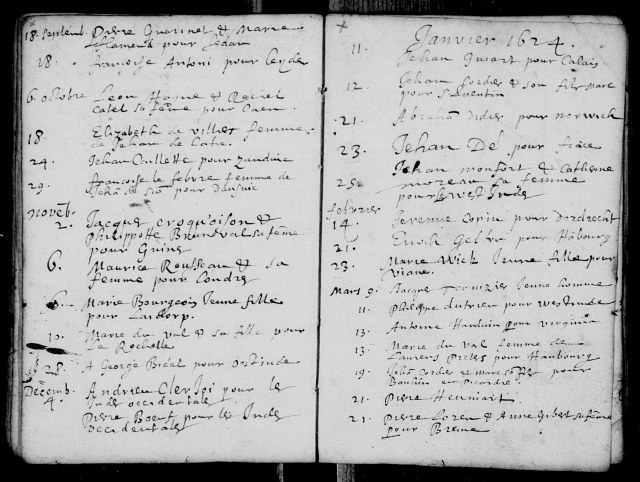
Page from the church register of the Walloon Church, Amsterdam noting the departure of Jean Montfort and family “pour les West Indes.” January 1624. Click to enlarge.
Two days later, on January 25, they boarded the Eendracht (the English translation is “Unity”) and began their journey. The passengers on that tiny ship included about a dozen families, most if not all Walloons, and about 30 soldiers and seamen.
By tens and twenties they came in the years 1624 and 1625, pitching on the inhuman waves in yachts, galiots, ketches, pinks and pinnaces, well-crafted but still frightfully vulnerable wooden vessels, banging around in the narrow and rheumatic below-decks, with pigs rooting and sheep bleating hollowly at every slamming swell, with the animal reek and their own odors of sickness and sour filth, each clutching his or her satchel of elixirs to ward off the plague, the devil, shipwreck, and “the bloody flux.”
The Eendracht arrived in New York Harbor in April or May 1624. What the passengers found at the end of the journey was the virgin wilderness recreated by the Mannahatta Project, dotted with Native American settlements.
A second Dutch ship – the Nieuw Nederland – made the crossing months later, bringing additional settlers. But only four of the families arriving that fateful year – the Rapeljes, du Trieux, Vignes and Montforts, all Walloons – successfully managed to put down roots. The other settlers either died or returned back to Europe.
The first six years
After their arrival, the passengers on the Eendracht split off in different directions. Two families and six men were sent to the mouth of the Connecticut River, another two families and eight men were sent to a island on the Delaware River, and eight men took possession of Nutten Island (now Governor’s Island). The remaining passengers – about eight families and ten men, including the Montforts – were sent 150 miles up the Hudson River where it meets the Mohawk River – what later became Albany.
Shorto imagines their arrival thus:
Here the newcomers disembarked and stood defenseless before the towering pines. For shelter initially they dug square pits in the ground, lined them with wood and covered them with bark roofs (a minister who arrived a few years later, when proper houses were being built, sneered at the “hovels and holes” in which the first arrivals “huddled rather than dwelt.”
There, they were put to work building a fort – Fort Orange. But by 1626, the group’s leaders got entangled in disputes among the Native tribes. The settlers formed an alliance with the Mahicans, only to suffer an ambush by their enemies, the Mohawks. The fragile colony was in peril.
In the fall of 1626, after the third harvest was complete, the eight families living at Fort Orange were sent back down the Hudson River to a a new settlement on the southern tip of the island of Manhattan. Earlier that year, Pieter Minuit purchased the island from the Lenape Indians for 60 guilders. They would be its first European residents.
In those early years, the Montforts probably lived in a rough shelter along the East River, where they would be protected from the westerly winds. We don’t know the exact nature of the their work, but we can assume that the settlers were put to work to clear and cultivate land for farms and buildings. Sadly, many records from those New Amsterdam’s first years have been lost.
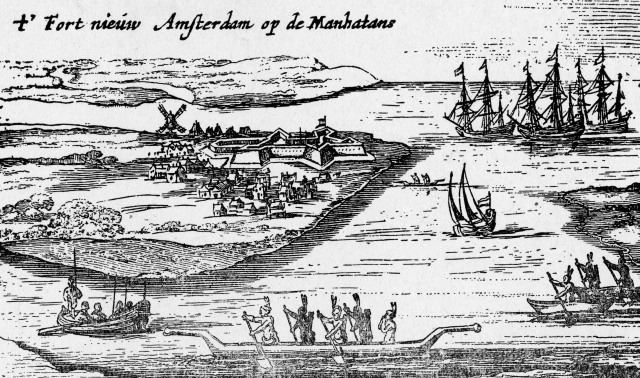
The earliest known image of New Amsterdam dating from 1626. The view, from the Brooklyn shore looking west, is reversed, probably due to the lithographic process. Click to enlarge.
A brief return to Amsterdam
Sometime after 1630, when their six years of indentured servitude was completed, it appears that the Montforts went back to Amsterdam for a time. Perhaps there was family business to attend to. Or maybe they needed to find Pierre a bride. During their time back in Amsterdam, Jean and Pierre made a living as lace weavers.
On March 1, 1636, they registered their intention to marry at the Walloon Church.
Pierre Montfoor, from Valenchijn, age twenty, assisted by his father Jean Montfoor, lace weaver, living on the Engelspadt, to marry Saera de Plancke, from Amsterdam, age twenty-one, assisted by her mother Saera Fruckenier, living at above.
The couple was married on March 23, 1636.
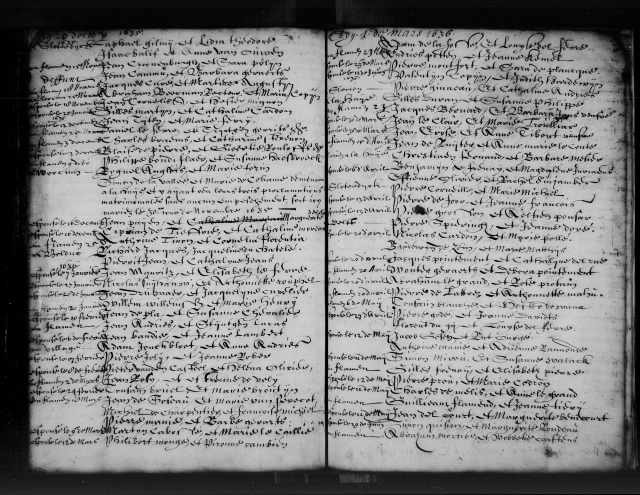
Marriage record for Pierre Montfort and Sara du Plancque dated March 23, 1636 (see upper left corner). Click to enlarge.
Back in the New World
Some time before 1639, the expanded family returned to New Netherland. There is not much information available about Jean and Jacqueline during the years after that, except that they remained in the colony until their deaths. But we do know a fair amount about Pierre and Sarah.
From various land records, we see that Pieter Monfoort (he began to spell his name in the Dutch fashion) and Sarah established themselves in the Wallabout area of Brooklyn, between the Manhattan and Williamsburg Bridges where the Brooklyn Navy Yard is located today. The name is thought to be derived from the Dutch Waal bocht (Walloons’ bay), a reference to the original settlers.
In 1639, Pieter first purchased land in partnership with Cicero Alberti, said to be the first Italian resident of North America. Records show that the land measured “in breadth 300 paces, with the same breadth straight into the woods.” Under the partnership agreement, set for a term of four years, the plantation would grow tobacco, corn and other grains.
Alberti and his wife Judith Manje remained close friends with Pieter and Sarah until their death at the hand of Indians in 1655.
By 1641, Pieter expanded his holdings to include “a piece of land for a Tobacco plantation, lying on Long Island in the bend of Meyrechkawick, bounded by Jan Monfoort on the east, and Pieter Italiaen on the west, extending along the marsh into the woods 70 rods, and 220 rods along the land of Jan Monfoort, to the woods 70 rods, again to the marsh in a northerly course 227 rods along the land of Pieter Italiaen, amounting to 25 morgen and 8 rods [a little over 50 acres].” He acquired additional land in 1643, provided it did not interfere with any other claim.
Pieter and Sarah were charter members of the Dutch Reformed Church in the Flatlands section of Brooklyn, which was founded in 1660 and still stands. In his later years, Pieter was one of the colony’s most prosperous residents. In 1658, he was appointed magistrate for the town of Breuckelen.
Pieter died on January 4, 1661, three years before the English takeover. Sarah married Lambert Bosch two years later. It is not clear when she died. She is last named in records of the Dutch Reformed Church in 1664, when she was a witness to a baptism.
Pieter and Sarah had seven children. The sixth, my eighth great-grandmother Sara Pieterse Monfoort (1656-1704), married Nicolaus Claes Pieterse Wyckoff (1646-1714), the son of another prominent early settler of New Netherlands colony. More about them in another post.
Sources:
Harry Macy, Jr., “375th Anniversary of the Eendracht and Nieuw Nederland,” The New York Genealogical & Biographical Society Newsletter, Winter 1999.
George Olin Zabriskie, “The Founding Families of New Netherland,” De Halve Maen, Jan., Apr. and July 1972.
George Olin Zabriskie, “A Chronology of New Netherland,” De Halve Maen, July 1972.
Eric W. Sanderson, Mannahatta: A Natural History of New York City (Harry N. Abrams, Inc., 2009).
Russell Shorto, The Island at the Center of the World (Vintage Books, 2005).

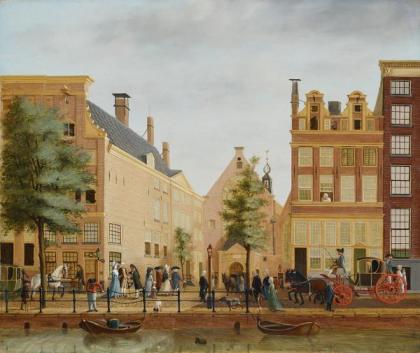
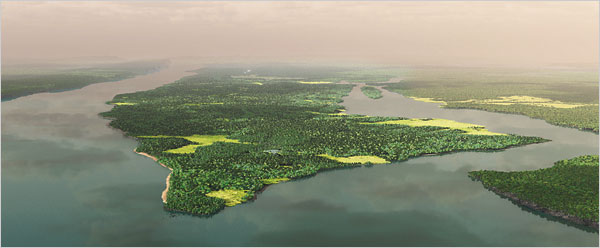
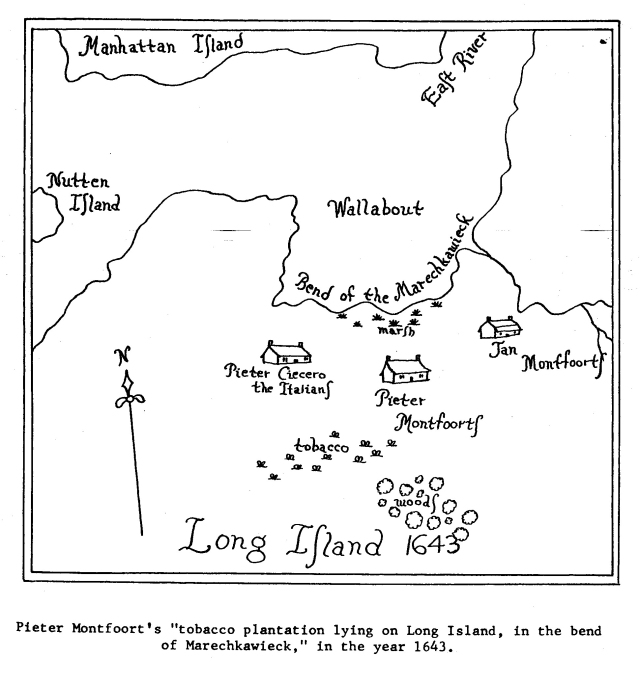
Fascinating and enlightening – always a pleasure to read your blog!
I also am descended from Jean and Jacqueline and have been thrilled to also uncover the information you have written about. A few years ago, I attended worship at the Walloon Church in Amsterdam, and brought home a goal Huguenot cross from a small wooden case in the church, which is much the same as drawings of it from long ago. I had never seen the church logs, and can never thank you enough.
Well, hello, cousin, and thank you for this. I have just discovered (a couple hours ago) that Jean and Jacqueline Montfort are my 10th great grand parents. My line then goes down to Pieter (Pierre) Montfort and Sarah De Plancken, to Maria “Marietje” Pieterse Montfort and Dirck Gorris Storm, which leads from their son over to the Van Tassel family of Sleepy Hollow legend; a line that includes many exciting and interesting stories, such as my 10th great grand father Cornelius Jansen Van Texel (Tassel) married and had a son with Catoneras, daughter of a chief of a tribe on Long Island, New York who is historically described as a native American Princess and heiress to lands on Long Island, which she then passed down to her son, Jan Cornelissen Van Tassel my. 9th great grand father who, coincidentally, was born in New Amsterdam is 1625. It’s all just a bit mind boggling.
Mind boggling indeed! I did not expect to find a connection to those very first families who came over to New Netherlands colony. Living in Manhattan, as I do, I feel a bit more at home!
Jean Montfort is my 9th great grandfather. I descend from him through Pieter, Peter, Jacobus, etc. My father was the last male of that line. I grew up on Long Island. Many of that line are buried in a cemetery in Upper Brookville.
I am going to Amsterdam in May, and am looking forward to visiting the Walloon Church. Are the records pictured in your post taken from records there, or have those records been transferred to Leiden? I have tried to contact the church through the email address on its website, but have received no response.
Your cousin,
Debbie Monfort Firebaugh
This was such a great find. I discovered last night of my ancestry to Pieter Montfoort, a 10th Great Grandfather, and the best part that I currently live in Wallabout, Brooklyn. How amazing to find this connection.
John,
Thanks for an interesting blog. Sara Montfoot, wife of Nicholas Pieterse Wyckoff, is my ninth great-grandmother. As you probably know, Nicholas’s father Pieter Wyckoff started out as an indentured servant too and later became prosperous. Did you know that through Sara and Nicholas, we are about 7th cousins, several times removed, from the Wright Brothers?
I think Jean Montfort’s story, like those of most early immigrants to this country, is especially relevant today. Our ancestors were impoverished, indentured servants, little better than slaves. Yet they worked hard, prospered and suffered too. They built a great country. Who is to say that current immigrants and their progeny will not do the same?
With best regards,
Bob Carl,
Marietta, Georgia
Errata: I meant to write Pieter Monfoort. His father was Jean Monfoort who married Jacqueline Moreau and whose grandfather was Brisse Monfort (1560-1610) and that is as far as I can trace our Monfort ancestors.
Another voice to add as my paternal 9th great grandparents are Jean Monfoort and Jacqueline Moreau. My 6th great grandmother was Margaret Montfort who married Cornelius Voorhees. She was daughter of Jacob and Leah Banta. I live in Texas but will be in the Mohawk Valley for conference on the Revolution in early June; chasing down my Swiss ancestors on my maternal side.
Added your wonderful essay to entries for the family on the free site familysearch.org.
I’m also descended from Sarah Montfoord Wyckoff! I suppose this isn’t a huge surprise, if you trace your roots to Amwell. Sarah Wyckoff Skillman (1805-1895) was Susan Skillman Piggott’s mother, and she’s my great-great-grandmother. I grew up in Hopewell hearing stories from her time.
I’ll be interested to hear what more you learn about our family! All my best–Cousin Jill